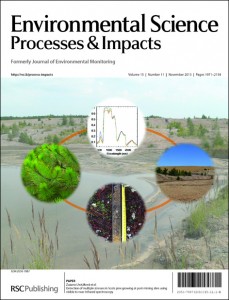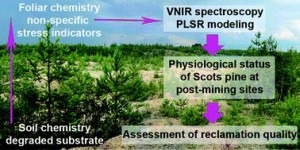Novel spectroscopic techniques could provide a useful tool for monitoring the physiological status of vegetation in post-mining sites, according to a new study by Zuzana et al from the Charles University in Prague, which featured as our Cover Article in Issue 11.
Long-term lignite mining has caused widespread ecological damage in many areas across the world. The principal cause of these problems is acid mine drainage, which causes increased acidity of soil and water environments and subsequent mobilization of heavy metals e.g. Cd, Zn, Co, Cu and Ni leading to plant uptake from contaminated soils.
Reforestation is a common method for reclamation of post-mining sites with Scots pine being a popular option due to its high ecological tolerance to diverse environments. Monitoring the effects of low pH conditions and heavy metal contamination and identifying key non-specific indicators of stress in this vegetation is therefore important in order to best develop the most effective remediation strategies for post-mining locations.
However, only a limited amount of work has so far been performed under field conditions to establish the effects of high acidity and heavy metal levels on the biochemical processes within vegetation and suitable biomarkers for these effects have not yet been identified. In this study, Zuzana et al. outline the results of a pilot study for monitoring reclaimed post-mining sites, developing a method to identify the key physiological stress factors in Scots pine trees.
Spectroscopic methods are becoming increasingly popular in environmental monitoring. They potentially offer a cheaper and faster alternative to conventional biochemical analysis. The approach in this study modelled the relationship between the visible to-near-infrared (VNIR) spectral properties of Scots pine needles and their key physiochemical properties, measured in the laboratory.
The most suitable biochemical traits identified as non-specific stress indicators for Scots pine trees were ; relative water content (fraction of weight decrease after drying), content of photosynthetic pigments (chlorophyll a+b and carotenoids, and the ratio of these two components) and concentration soluble phenolic compounds.
The technique was applied to four sites in northwest Czech Republic, each exhibiting different levels of physiological stress. The method was able to successfully separate the different sites, using at least three of the above variables, based on their spectral reflectance data and validated using bootstrapped partial least squares regression (PLSR) modelling predictions.
The study demonstrates the potential use for the VNIR spectroscopic technique for estimating the physiological status of vegetation in post-mining sites. The method has potential use in larger-scale monitoring studies, allowing simple and quick assessment of reclamation quality in post-mining regions using air-born or satellite hyperspectral data.
This paper is an Environmental Science: Processes & Impacts HOT article and is of interest to researchers interested in contaminated land remediation, specifically post-mining sites, or anyone that likes trees.
Detection of multiple stresses in Scots pine growing at post-mining sites using visible to near-infrared spectroscopy, Lhotáková Zuzana et al, DOI: 10.1039/c3em00388d












